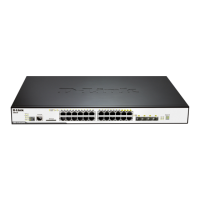xStack® DGS-3120 Series Layer 3 Managed Gigabit Ethernet Switch Web UI Reference Guide
396
ingress ARP and IP broadcast packets and packets from un-trusted IP addresses for five seconds. After another
five-second checking interval arrives, the Switch will again check the ingress flow of packets. If the flooding has
stopped, the Switch will again begin accepting all packets. Yet, if the checking shows that there continues to be too
many packets flooding the Switch, it will stop accepting all ARP and IP broadcast packets and packets from un-
trusted IP addresses for double the time of the previous stop period. This doubling of time for stopping these
packets will continue until the maximum time has been reached, which is 320 seconds and every stop from this
point until a return to normal ingress flow would be 320 seconds. For a better understanding, please examine the
following example of the Safeguard Engine.
Figure 8-92 Mapping QoS on the Switch
For every consecutive checking interval that reveals a packet flooding issue, the Switch will double the time it will
discard ingress ARP and IP broadcast packets and packets from the illegal IP addresses. In the example above,
the Switch doubled the time for dropping ARP and IP broadcast packets when consecutive flooding issues were
detected at 5-second intervals. (First stop = 5 seconds, second stop = 10 seconds, third stop = 20 seconds) Once
the flooding is no longer detected, the wait period for dropping ARP and IP broadcast packets will return to 5
seconds and the process will resume.
In Fuzzy mode, once the Safeguard Engine has entered the Exhausted mode, the Safeguard Engine will decrease
the packet flow by half. After returning to Normal mode, the packet flow will be increased by 25%. The switch will
then return to its interval checking and dynamically adjust the packet flow to avoid overload of the Switch.
NOTICE: When Safeguard Engine is enabled, the Switch will allot bandwidth to various traffic flows
(ARP, IP) using the FFP (Fast Filter Processor) metering table to control the CPU utilization

